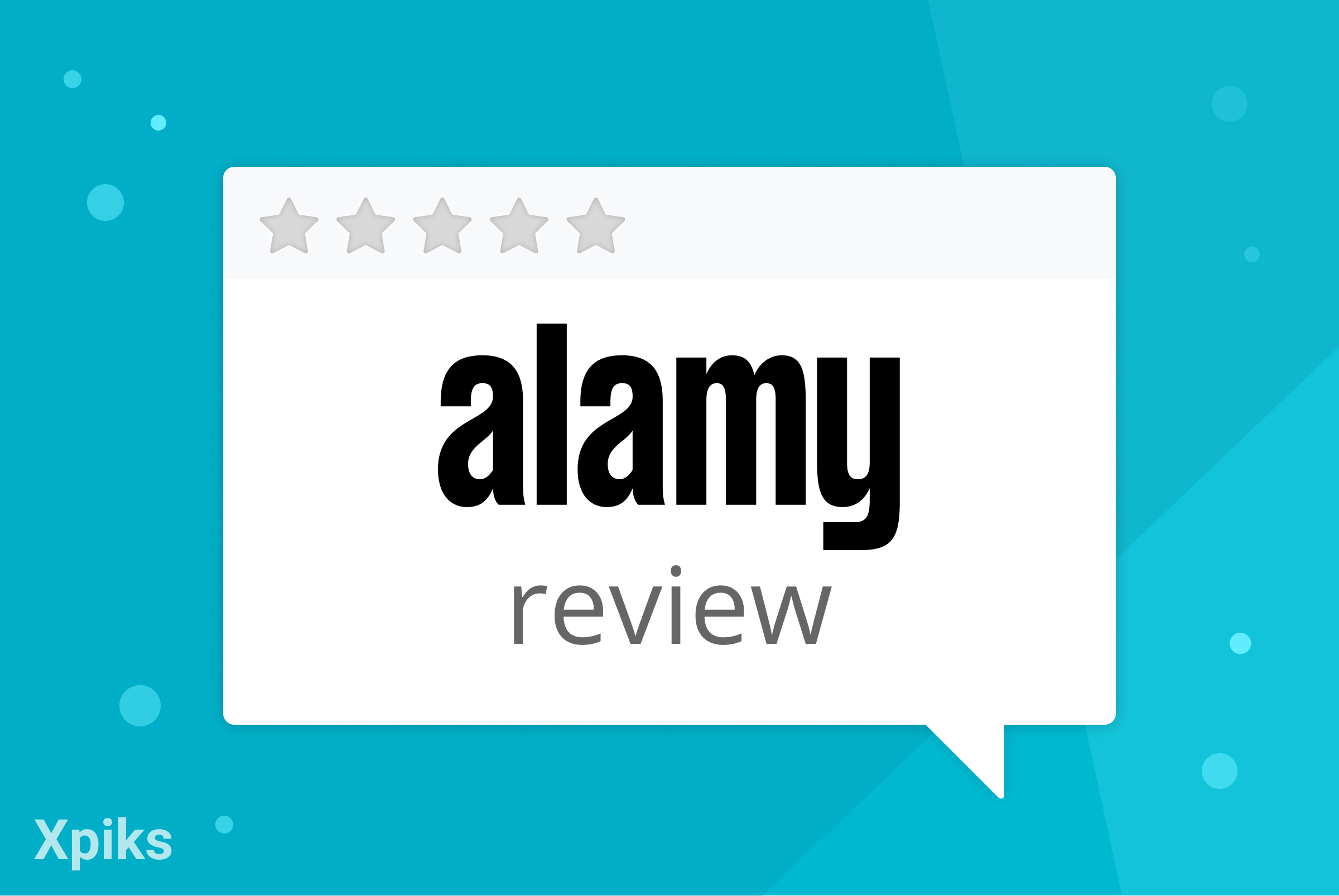Alamy is a totally different player in the game of microstock.
Not only it is one of the oldest agencies out there, but it still thrives and even makes contributors happy (or at least happier that many others). Alamy has highest contributor payouts percentages in industry and while monthly earnings are usually inconsistent, they have pleasant spikes from time to time.
You can also become an Alamy contributor and earn money. In this blogpost we covered everything you need to know about them.
History of Alamy
Alamy was launched in September 1999 in Britain as a privately owned stock photography agency. It boasts one of the world’s most diverse creative and editorial stock imagery collections of photographs, vectors, and 360-degree panoramic images.
In 2020, Alamy was acquired by PA Media Group, the UK’s leading provider of cross-platform news, sport and entertainment data, content, and services, giving Alamy contributors access to broader markets and audiences.
Key statistics on Alamy:
- Close to 300 million stock photos, vectors, and videos from individual and agency contributors;
- On average, more than three million images are added to Alamy’s platform each month;
- The business has close to 120,000 customers worldwide.
Alamy has changed their commission level in 2021, which follows a series of prior changes.
What makes Alamy stand out
In the time of declining revenue streams and ROI from microstock agencies, it is refreshing to see prices that reflect the value of your work. Alamy can be considered the last bastion of fair prices in the industry and as such, it deserves praise for its resiliency.
Even though changes to allow Alamy customers to acquire assets for lower prices have been implemented, contributors have an option to opt out of these plans. Let’s take a look at why it makes sense to become a contributor and what makes Alamy stand out in a crowded microstock space.
Bigger sales and a more flexible licensing structure
Alamy’s licensing structure provides real flexibility and often results in much higher payouts to contributors. Sales in the range of $200-350 USD (gross) are not unheard of and do happen. Sales in the range of $20-60 (gross) happen more often and these sales still represent substantially better prices than is offered by other agencies.
Highest payouts percentage in the industry
Alamy contributor payout percentage is the highest in the industry with contributors receiving 40% of earnings from a sale (or 30% if the asset is sold through Alamy Distributor Partners). A contributor must sell a minimum $250 of content in the revenue year to qualify for this commission.
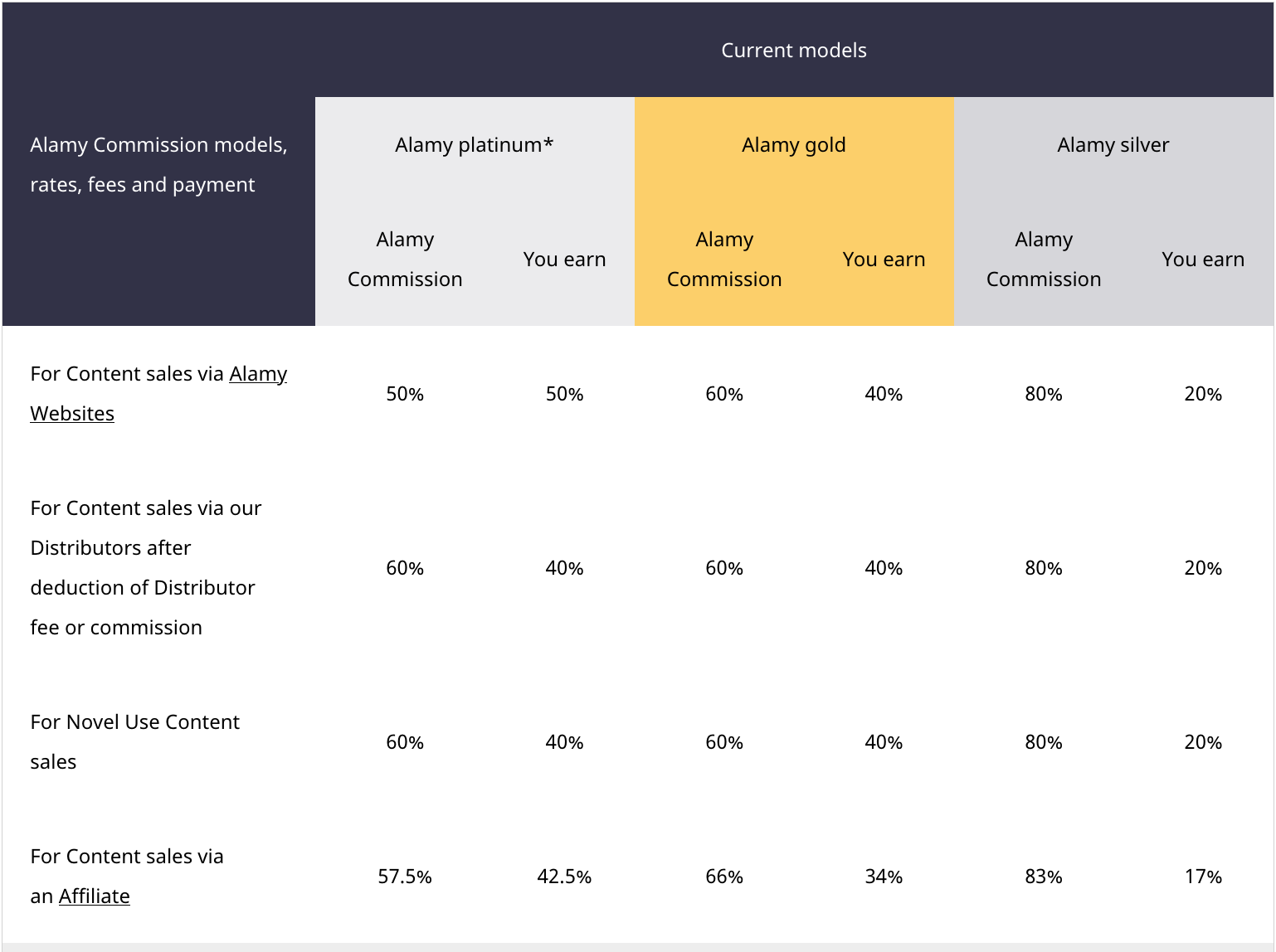
Contributors are paid in Alamy Silver band if they fail to reach $250
New contributors should set their expectations when it comes to working with Alamy.
- It takes some time before your content starts selling on Alamy. The common wisdom is to have at least 1K assets in your portfolio and it takes up to a year to see your first sale.
- Alamy has a policy of refunding customers who are not satisfied with the purchased asset. This means the sale that is posted in your Dashboard in real-time can be later reversed and shown as “refunded”. It rarely happens, but as a contributor, you should be aware that counting your chickens makes sense only when cleared funds arrive in your bank account.
- Big sales (
$150+) do happen, but they are far and few between, and counting on them as a predictable source of income is not wise. - Alamy is known to be inconsistent when it comes to producing income - you may have a zero-dollar month followed by a significant spike the month after.
- You have more chances of selling editorial content on Alamy compared to average microstock-oriented content, although this type of imagery is sold as well.
- Alamy does not accept video footage into its collection at the moment.
How to become an Alamy contributor
The process of becoming an Alamy contributor is straightforward. First, you need to sign-up for an account. Then you can submit the first batch of images to the Alamy Quality Control Team from your dashboard page. Once approved, you will be able to submit your images to the Alamy online collection and sell them.
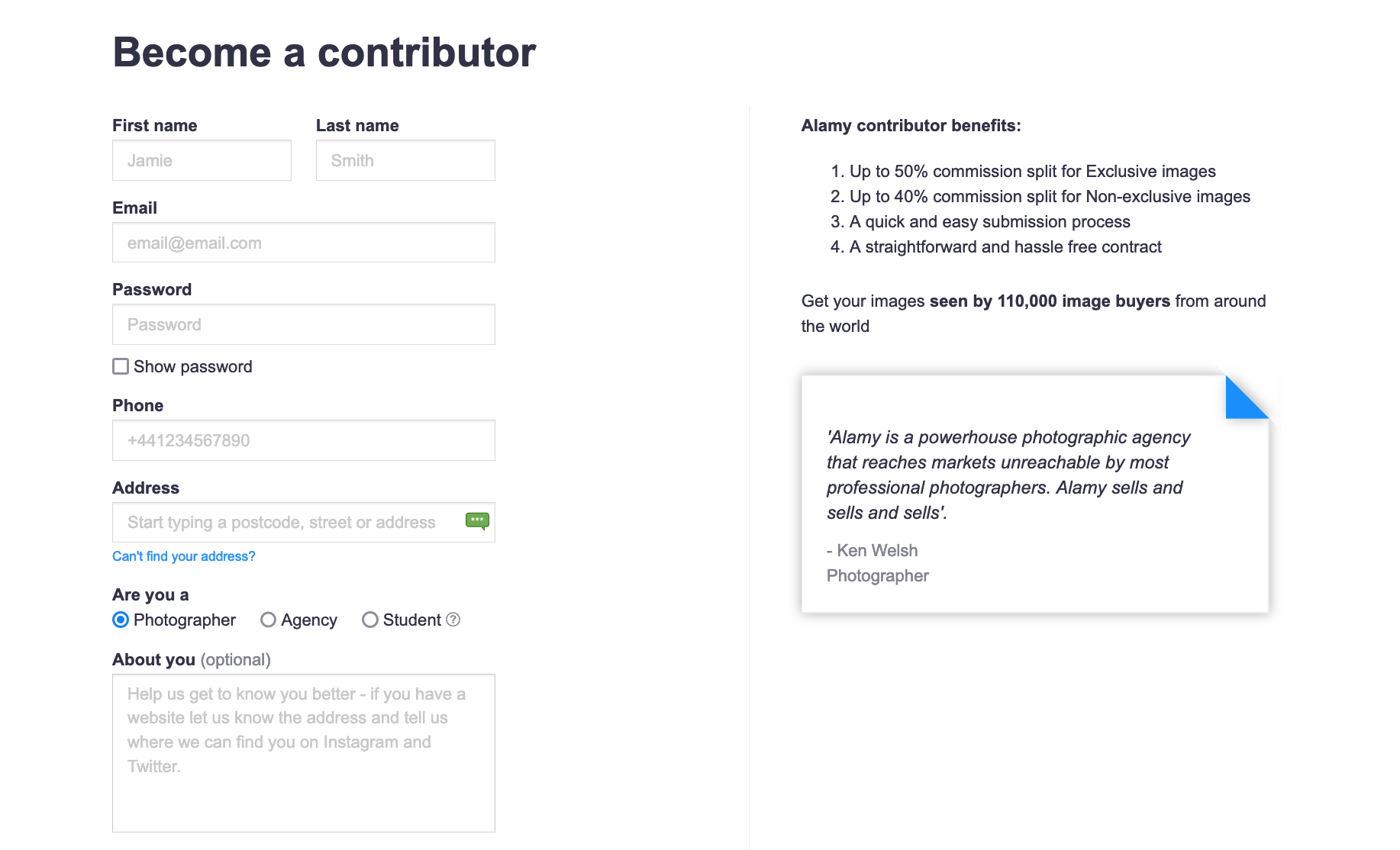
Alamy sign-up form
For new and aspiring contributors, Alamy Contributor Portal provides valuable resources and information, including access to the Contributor Forum, FAQs, Blog, student-related information, and the mobile application download. For existing contributors, Alamy provides email support, which is fast, efficient, and detailed.
Contributor Dashboard Overview
Once you are registered and your work is approved the Contributor Dashboard page will provide a snapshot of your portfolio performance and other general information. Compared to other agencies, the Dashboard Overview section looks a bit outdated from a design perspective, but it is functional and provides access to all the required data you might need.
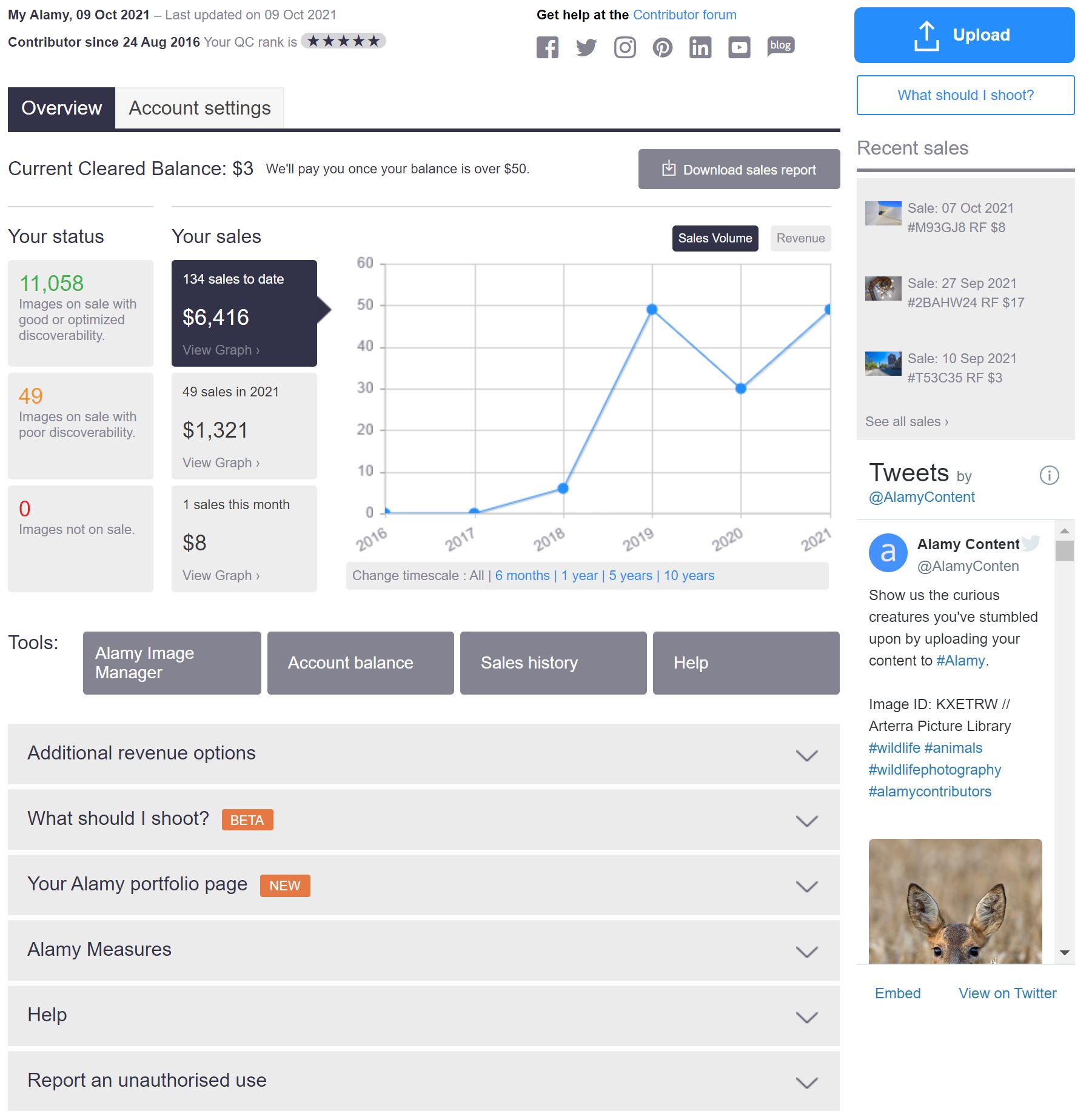
Alamy dashboard
Most of the Dashboard options provide valuable insights about your sales history, account balance, ability to opt-out from specific plans, and access to your Alamy Image Manager, where you can upload and keyword your images.
We recommend getting familiar with the Alamy Measures section where you can find statistics as to how often your content was viewed, your Click Through Rate, and the number of sales (with links to the sold assets).
Alamy Image Manager - providing metadata and uploading your assets
Once you click on Alamy Image Manager, you get redirected to the interface where you can add metadata and submit your images.
There are 2 ways to upload images to Alamy - through FTP (which is better-suited for mass-uploading your assets) and through the Dashboard using a web upload interface (limited upload for only few files). Usually it’s best to use a software like Xpiks to automate your workflow and upload to multiple agencies at once, including Alamy.
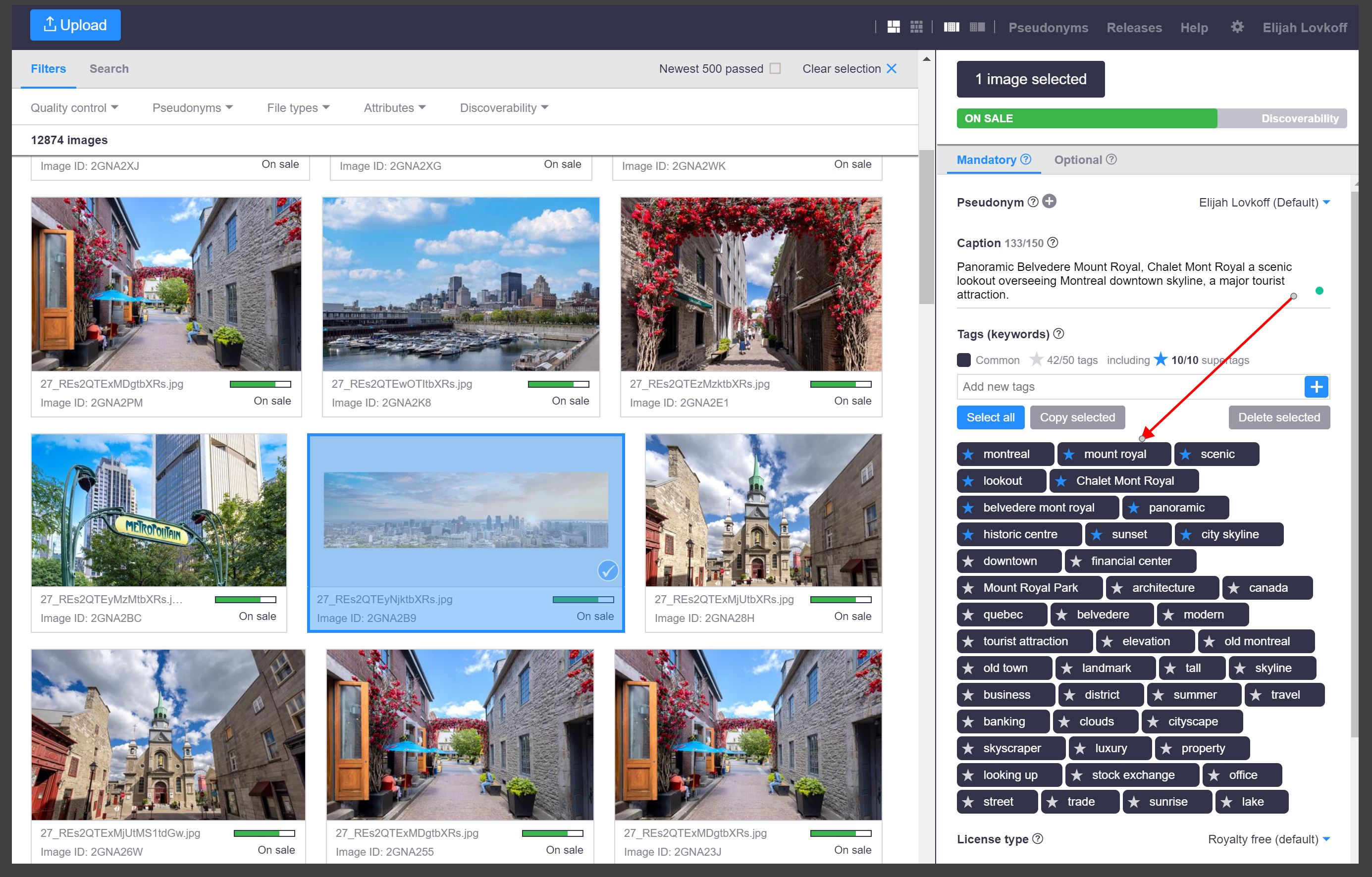
Alamy Image Manager
Adding metadata for Alamy
Adding keywords and titles to your assets
Besides regular keywords, Alamy uses a unique keyword feature called supertags (highlighted in the screenshot above). Alamy defines supertags as:
“These are the tags that you feel are the most relevant to the image. In Alamy Image Manager, you can add up to 10 supertags and the search engine will place extra priority on these. Make sure you select the most relevant words only and use them wisely.”
Read more about Alamy’s approach to keywording here.
Providing additional information
You will also need to set categories and information like editorial vs. commercial, property releases, exclusivity, etc. All of these options are accessible when you click on the image you want to keyword.
Licenses
A special note about licenses. Unlike other agencies, Alamy gives contributors the choice of using Rights Managed License or Royalty Free License.

Rights-Managed license
Alamy defines the difference between these types of licenses as:
RM stands for Rights Managed. With this license, the customer only pays for what they’re using the image for. RM licenses can define how, where, when, or for how long an image is being used.
RF stands for Royalty-Free. Customers pay a one-off fee to use the image with no restrictions on how they use it, or how long they use it.
RM licenses usually yield more money but the customer base who is looking for RM licenses has decreased greatly in the last few years. Alamy acknowledged as much:
Our customers are increasingly asking for broader rights so we’d recommend selling your images as RF but the decision is yours.
If you consider submitting your content as Rights Managed, it is best to make sure the content is unique in some way to increase the chances of it being sold. It can be a rare geographical location, a unique event, or something that helps to clearly distinguish the content from the RF collection.
You can read more about Rights-Managed licenses in Xpiks blogpost.
Customizing plan memberships
One thing that some contributors struggle to find is an opt-out option for plans that don’t seem attractive to them. It is done through the Alamy Dashboard, under “Additional Revenue Options” as per the screenshot below:
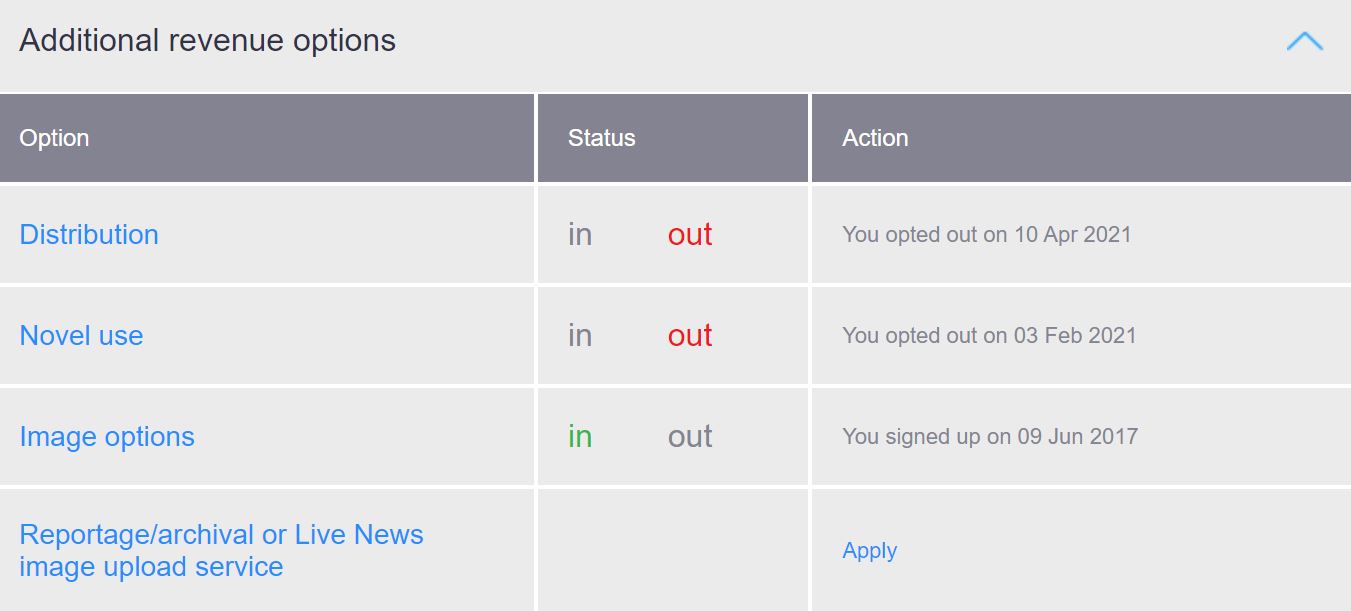
Plan memberships
Submitting and accepting images into Alamy Stock
Before assets can be accepted to the Alamy collection and made available for customers to purchase, your images must pass Alamy QC (Quality Control). Unlike other agencies that accept or reject images based on individual items, Alamy does it on a per batch basis. To illustrate it, if you submit 100 images and one or more images in the batch fail Quality Control, the whole batch is rejected. With this in mind, we recommend new users to submit images in smaller batches.
Another important aspect to consider - if multiple submissions fail QC, Alamy will “freeze” your account and prohibit further uploading of images for 10 days. Such a “freeze” may also affect your contributor star rating. Uploading images shot with a mobile phone can also trigger this temporary ban.
Common post-processing mistakes and reasons for rejections are summarized in a PDF document created by Alamy and can be downloaded in case you need an offline version.
Alamy QC review times are one of the fastest in the industry and it only becomes faster when your contributor rankings get higher.
Alamy Live News
Photographers that shoot news-worthy content, can use Alamy Live News to monetize it. Alamy gives detailed information about news submission guidelines and provides an easy infographic to illustrate the process.
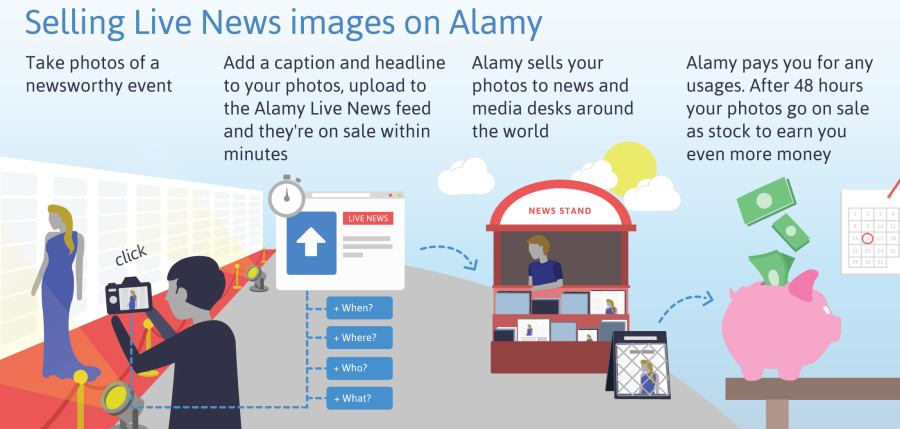
Live news submissions guidelines
Alamy Payout Structure
Most agencies pay contributors once a month on a set date. Alamy takes a different approach. Even though the sales are posted to the Contributor Dashboard in real-time as they happen, the funds are not available to contributors until the payments are cleared.
This is how Alamy explains the difference between cleared and uncleared payments:
“Cleared” means we’ve been paid by the customer. Because we show you sales as they happen you can also see sales we’re waiting to be paid for (uncleared). The time it takes for a sale to clear depends on the customer but it’s usually between 45 days and 3 months.
In other words, it may take up to three months to receive a payout, provided that the amount of the cleared payment exceeds $50 USD as per Alamy’s policy. If your payout is less than $50, the following message will be displayed in your Dashboard.

Uncleared earnings notification
Alamy can pay their contributors USD, GBP, or EUR via PayPal, Skrill, or funds transfer. Unlike other agencies, Alamy doesn’t provide any tax forms or require that contributors fill them out. It’s up to contributors to declare any earnings they make from selling images on Alamy.
Alamy Contributor Support
Alamy’s support is quick, efficient, and comprehensive. It is provided over email dedicated to contributor support ([email protected] ) and can be found on the photographers’ contact page. In addition, contributors can find help on Alamy Contributor Portal or seek peer support at Alamy Contributor Forums.
Besides contributor-to-support interactions, Alamy provides useful tips through the actively maintained blog, or on the “What should I shoot” page (available only to contributors) that contains tips about imagery that is in high demand.
Alamy Contributor Tips
- New contributors are advised to be patient. It takes a while before the content starts selling. Although it is frustrating, numerous contributors report that “it just takes time”.
- Alamy does not produce regular sales as most microstock agencies do. You can have no sales in one month, followed by a very strong month, followed by a mediocre or average month. Our advice is to use a yearly baseline to evaluate your performance rather than a monthly one.
- Alamy does not employ the same search algorithms that other agencies do. Your content can be sold even if it is not found on the first ten pages of the search for a particular term.
- We advise new contributors to submit in smaller batches in order to get a feel of how Alamy QC works and to avoid multiple images being rejected.
- If you submit to multiple stock agencies we recommend using mass-uploader software, such as Xpiks.
Drawbacks of Alamy
Even though Alamy has many good sides, the road has not been without the bumps. Contributors complain about few issues:
- Lower volume of sales than some years ago
- If you want to opt out from Distributor sales, as of time of this writing you can only do so in April
- When Alamy changed the commission structure, it messed up sales accounting so sales that were reported with the delay were accounted with new structure instead of the old one
- Reporting functionality per photo is incomplete so you cannot get a list of all downloads of all your photos
Conclusion
It is no secret that contributor earnings have been affected by the fall of microstock industry prices. It is becoming increasingly difficult to find an agency that can produce big payouts and provides fair pricing to content creators. Alamy is one of the few remaining agencies that continue to deliver both.
Whether you are looking to expand earnings from your professional photography or simply looking to have a side income through your passion, Alamy should be included in the list of agencies you work with.

